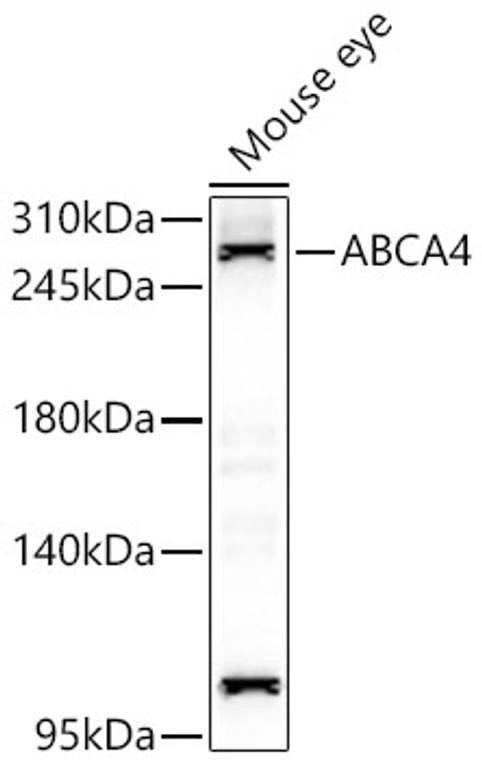| Host: |
Rabbit |
| Applications: |
WB |
| Reactivity: |
Mouse |
| Note: |
STRICTLY FOR FURTHER SCIENTIFIC RESEARCH USE ONLY (RUO). MUST NOT TO BE USED IN DIAGNOSTIC OR THERAPEUTIC APPLICATIONS. |
| Short Description: |
Rabbit polyclonal antibody anti-Retinal-Specific Phospholipid-Transporting Atpase Abca4 (2070-2273) is suitable for use in Western Blot research applications. |
| Clonality: |
Polyclonal |
| Conjugation: |
Unconjugated |
| Isotype: |
IgG |
| Formulation: |
PBS with 0.05% Proclin300, 50% Glycerol, pH7.3. |
| Purification: |
Affinity purification |
| Dilution Range: |
WB 1:500-1:1000 |
| Storage Instruction: |
Store at-20°C for up to 1 year from the date of receipt, and avoid repeat freeze-thaw cycles. |
| Gene Symbol: |
ABCA4 |
| Gene ID: |
24 |
| Uniprot ID: |
ABCA4_HUMAN |
| Immunogen Region: |
2070-2273 |
| Immunogen: |
Recombinant Protein corresponding to a sequence within amino acids 2070-2273 of human ABCA4 (NP_000341.2). |
| Immunogen Sequence: |
TYSGGNKRKLSTAIALIGCP PLVLLDEPTTGMDPQARRML WNVIVSIIREGRAVVLTSHS MEECEALCTRLAIMVKGAFR CMGTIQHLKSKFGDGYIVTM KIKSPKDDLLPDLNPVEQFF QGNFPGSVQRERHYNMLQFQ VSSSSLARIFQLLLSHKDSL LIEEYSVTQTTLDQVFVNFA KQQTESHDLPLHPRAAGASR QAQD |
| Tissue Specificity | Retinal-specific. Seems to be exclusively found in the rims of rod photoreceptor cells. |
| Post Translational Modifications | Proteolytic cleavage by trypsin leads to a 120-kDa N-terminal fragment and a 115-kDa C-terminal fragment that are linked through disulfide bonds. N-glycosylated. Phosphorylation is independent of light exposure and modulates ATPase activity. |
| Function | Flippase that catalyzes in an ATP-dependent manner the transport of retinal-phosphatidylethanolamine conjugates like the 11-cis and all-trans isomers of N-retinylidene-phosphatidylethanolamine from the lumen to the cytoplasmic leaflet of photoreceptor outer segment disk membranes, where N-cis-retinylidene-phosphatidylethanolamine (N-cis-R-PE) is then isomerized to its all-trans isomer (N-trans-R-PE) and reduced by RDH8 to produce all-trans-retinol (all-trans-rol) and therefore prevents the accumulation of excess of 11-cis-retinal and its schiff-base conjugate and the formation of toxic bisretinoid. May display both ATPase and GTPase activity that is strongly influenced by the lipid environment and the presence of retinoid compounds. Binds the unprotonated form of N-retinylidene-phosphatidylethanolamine with high affinity in the absence of ATP, and ATP binding and hydrolysis induce a protein conformational change that causes the dissociation of N-retinylidene-phosphatidylethanolamine. |
| Protein Name | Retinal-Specific Phospholipid-Transporting Atpase Abca4Atp-Binding Cassette Sub-Family A Member 4Rim Abc TransporterRim ProteinvRmpRetinal-Specific Atp-Binding Cassette TransporterStargardt Disease Protein |
| Database Links | Reactome: R-HSA-2453864Reactome: R-HSA-2453902Reactome: R-HSA-382556 |
| Cellular Localisation | MembraneMulti-Pass Membrane ProteinEndoplasmic ReticulumCytoplasmic VesicleCell ProjectionCiliumPhotoreceptor Outer SegmentLocalized To The Rim And Incisures Of Rod Outer Segments Disks |
| Alternative Antibody Names | Anti-Retinal-Specific Phospholipid-Transporting Atpase Abca4 antibodyAnti-Atp-Binding Cassette Sub-Family A Member 4 antibodyAnti-Rim Abc Transporter antibodyAnti-Rim Proteinv antibodyAnti-Rmp antibodyAnti-Retinal-Specific Atp-Binding Cassette Transporter antibodyAnti-Stargardt Disease Protein antibodyAnti-ABCA4 antibodyAnti-ABCR antibody |
Information sourced from Uniprot.org
12 months for antibodies. 6 months for ELISA Kits. Please see website T&Cs for further guidance





